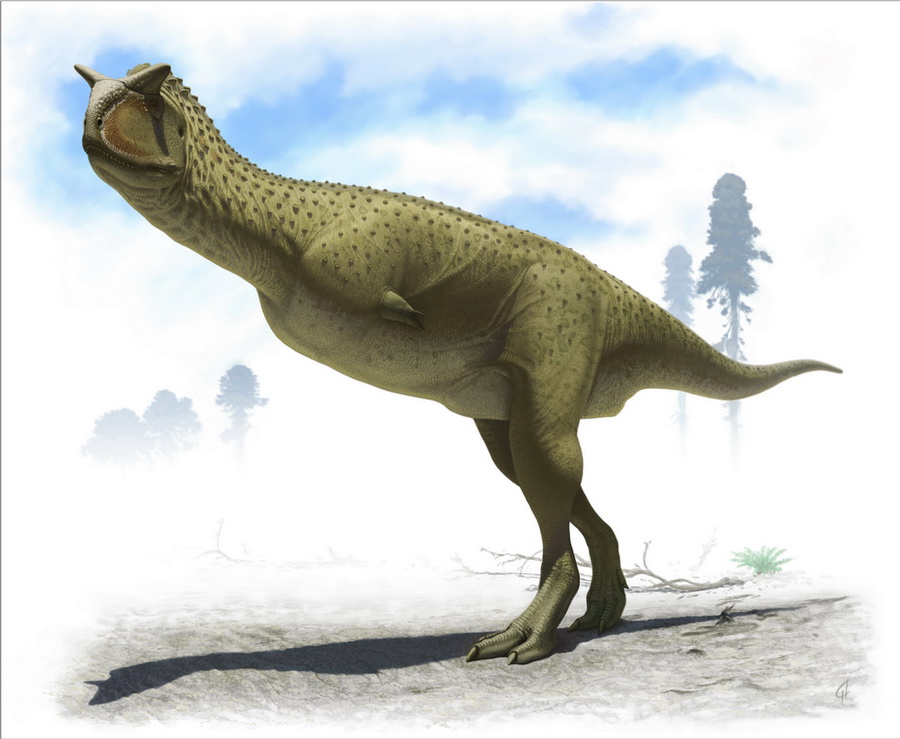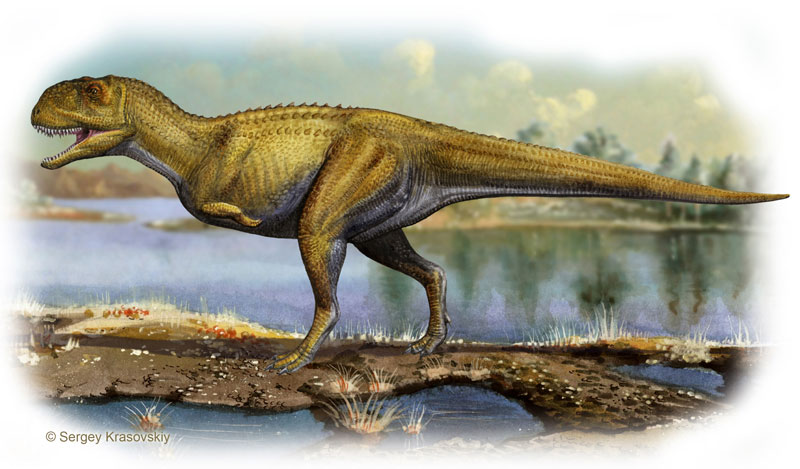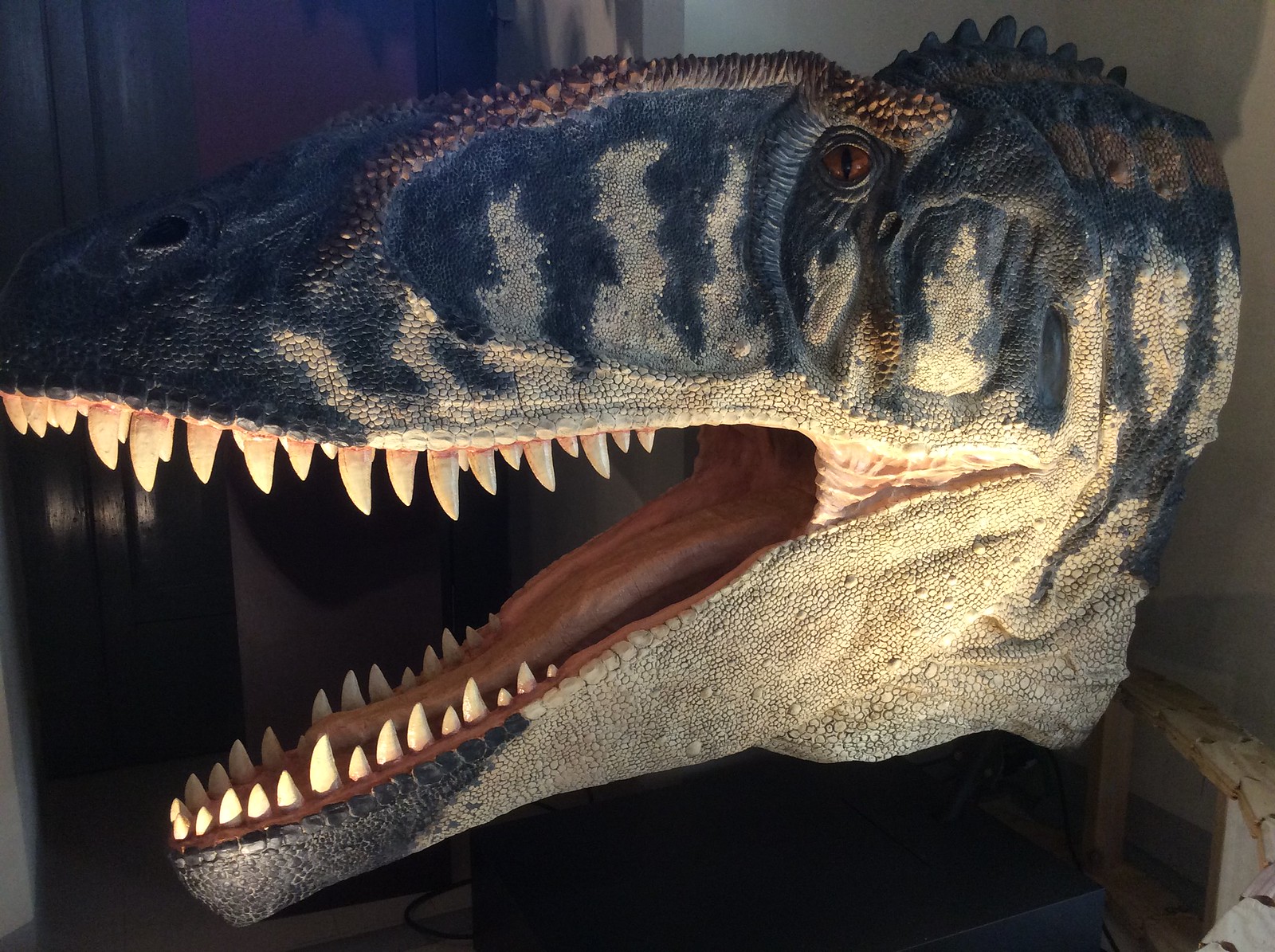Post by Carcharodon on Apr 5, 2014 20:44:19 GMT 5
Carnotaurus sastrei
Carnotaurus is a genus of large theropod dinosaur that lived in South America during the Late Cretaceous period, between about 72 and 70 million years ago. The only species is Carnotaurus sastrei. Known from a single well-preserved skeleton, it is one of the best-understood theropods from the Southern Hemisphere. The skeleton, found in 1984, was uncovered in the Chubut Province of Argentina from rocks of the La Colonia Formation. Derived from the Latin carno [carnis] ("flesh") and taurus ("bull"), the name Carnotaurus means "meat-eating bull", alluding to its bull-like horns. Carnotaurus is a derived member of the Abelisauridae, a group of large theropods that lived in the southern Landmasses of Gondwana during the late Cretaceous. Carnotaurus was a lightly built, bipedal predator, measuring 8 metres (26 ft) in length and perhaps weighing in a region of 2 tons. As a theropod, Carnotaurus was highly specialized and distinctive. It had thick horns above the eyes, a feature unseen in all other carnivorous dinosaurs, and a very deep skull sitting on a muscular neck. Carnotaurus was further characterized by small, vestigial forelimbs and long and slender hindlimbs. The skeleton is preserved with extensive skin impressions, showing a mosaic of small, non-overlapping scales measuring approximately 5 mm in diameter. The mosaic was interrupted by large bumps that lined the sides of the animal, and there are no hints of feathers. Carnotaurus was well adapted for running and was possibly one of the fastest large theropods.

Ekrixinatosaurus novasi
Ekrixinatosaurus (meaning "explosion-born reptile") is a genus of dinosaur which lived during the Late Cretaceous. It was a theropod of the Abelisauridae family. Its fossils have been found in Argentina. The type species, Ekrixinatosaurus novasi, was first described in 2004 by Argentinian paleontologist Jorge Calvo, and Chilean paleontologists David Rubilar-Rogers and Karen Moreno. It was discovered in the Candeleros Formation, a geologic formation that outcrops in Río Negro, Neuquén, and Mendoza provinces of Argentina. The formation dates from 100-97 mya. Ekrixinatosaurus was a relatively large abelisaurid; using the closely related Skorpiovenator as a basis yields sizes of roughly 7-8 meters (23-26 ft) in length.

Carnotaurus is a genus of large theropod dinosaur that lived in South America during the Late Cretaceous period, between about 72 and 70 million years ago. The only species is Carnotaurus sastrei. Known from a single well-preserved skeleton, it is one of the best-understood theropods from the Southern Hemisphere. The skeleton, found in 1984, was uncovered in the Chubut Province of Argentina from rocks of the La Colonia Formation. Derived from the Latin carno [carnis] ("flesh") and taurus ("bull"), the name Carnotaurus means "meat-eating bull", alluding to its bull-like horns. Carnotaurus is a derived member of the Abelisauridae, a group of large theropods that lived in the southern Landmasses of Gondwana during the late Cretaceous. Carnotaurus was a lightly built, bipedal predator, measuring 8 metres (26 ft) in length and perhaps weighing in a region of 2 tons. As a theropod, Carnotaurus was highly specialized and distinctive. It had thick horns above the eyes, a feature unseen in all other carnivorous dinosaurs, and a very deep skull sitting on a muscular neck. Carnotaurus was further characterized by small, vestigial forelimbs and long and slender hindlimbs. The skeleton is preserved with extensive skin impressions, showing a mosaic of small, non-overlapping scales measuring approximately 5 mm in diameter. The mosaic was interrupted by large bumps that lined the sides of the animal, and there are no hints of feathers. Carnotaurus was well adapted for running and was possibly one of the fastest large theropods.

Ekrixinatosaurus novasi
Ekrixinatosaurus (meaning "explosion-born reptile") is a genus of dinosaur which lived during the Late Cretaceous. It was a theropod of the Abelisauridae family. Its fossils have been found in Argentina. The type species, Ekrixinatosaurus novasi, was first described in 2004 by Argentinian paleontologist Jorge Calvo, and Chilean paleontologists David Rubilar-Rogers and Karen Moreno. It was discovered in the Candeleros Formation, a geologic formation that outcrops in Río Negro, Neuquén, and Mendoza provinces of Argentina. The formation dates from 100-97 mya. Ekrixinatosaurus was a relatively large abelisaurid; using the closely related Skorpiovenator as a basis yields sizes of roughly 7-8 meters (23-26 ft) in length.









